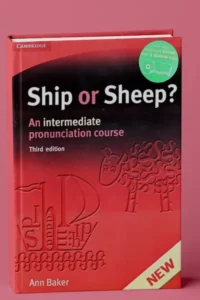This fully revised edition of the Pronunciation Course title is now in full colour with updated artwork. Faithful to the original style, the book retains its simplicity, with the emphasis on minimal pairs, and makes pronunciation practice light-hearted and accessible. Each unit offers comprehensive practice of sounds, with additional work on stress and intonation, and the accompanying audio CDs give lots of listening and pronunciation practice.
The book is available in a pack (comprising book and 4 audio CDs) for self-study, or separately for classroom use. Unlike the original edition, there is no separate Teacher’s Book.
Ship or Sheep? An Intermediate Pronunciation Course
Seven of the 50 units in this book are review units. Each of the other units introduces a different English sound, as well as other aspects of pronunciation (e.g. stress, intonation) which are also important for successful communication in English.
You can use this book either working alone or with a class + teacher.
You will need:
- equipment to listen to the CD, and equipment to record your voice.
- a small mirror to compare your lip positions with the pictures.
- Your mask (cut it out from page 185). You will use it at the beginning of most units (but not Unit l). You can also use it for extra practice of sounds that are difficult for you.
First, find out which units are most important for you. To do this:
- Do at least one of the Diagnostic Tests (see pages ix-xi). If you are working alone, do Test A. Test B needs the help of a teacher, native speaker or near-native speaker. If you are working with a teacher, he/she will decide whether you do the tests.
Decide whether you want to:
- work first on the most important units for you, or
- begin at the beginning and work through the book, spending more time on the most important units for you. You can choose to work simultaneously on Section A (vowels) and Section B (consonants). You can also do the seven review units.
Read, Maktng English sounds before beginning each section (see pages I-2, 79-80). This introduces some essential vocabulary.
Phonetic symbols used in this book are the International Phonetic Alphabet (IPA) (the contenrs page shows all the symbols used). you can use this book without knowing these symbols, but it is useful to learn them so that you can check the pronunciation of new words in a dictionary. The Cambridge Aduanced Learner’s Dictionary uses these symbols.
In most units (but not in Unit l), Exercise 2 Minimal palrs gives you practice in contrasting two sounds in words and sentences. If you don’t have one of the two sounds in your language, practising the pairs of sounds can sometimes help you to hear – and then produce – the English sound.
Dialogues are recorded.You can backtrack on the CD to repeat them as many times as you want. If you don’t like backtracking, listen to the dialogue after you have done the dialogue tasks.


